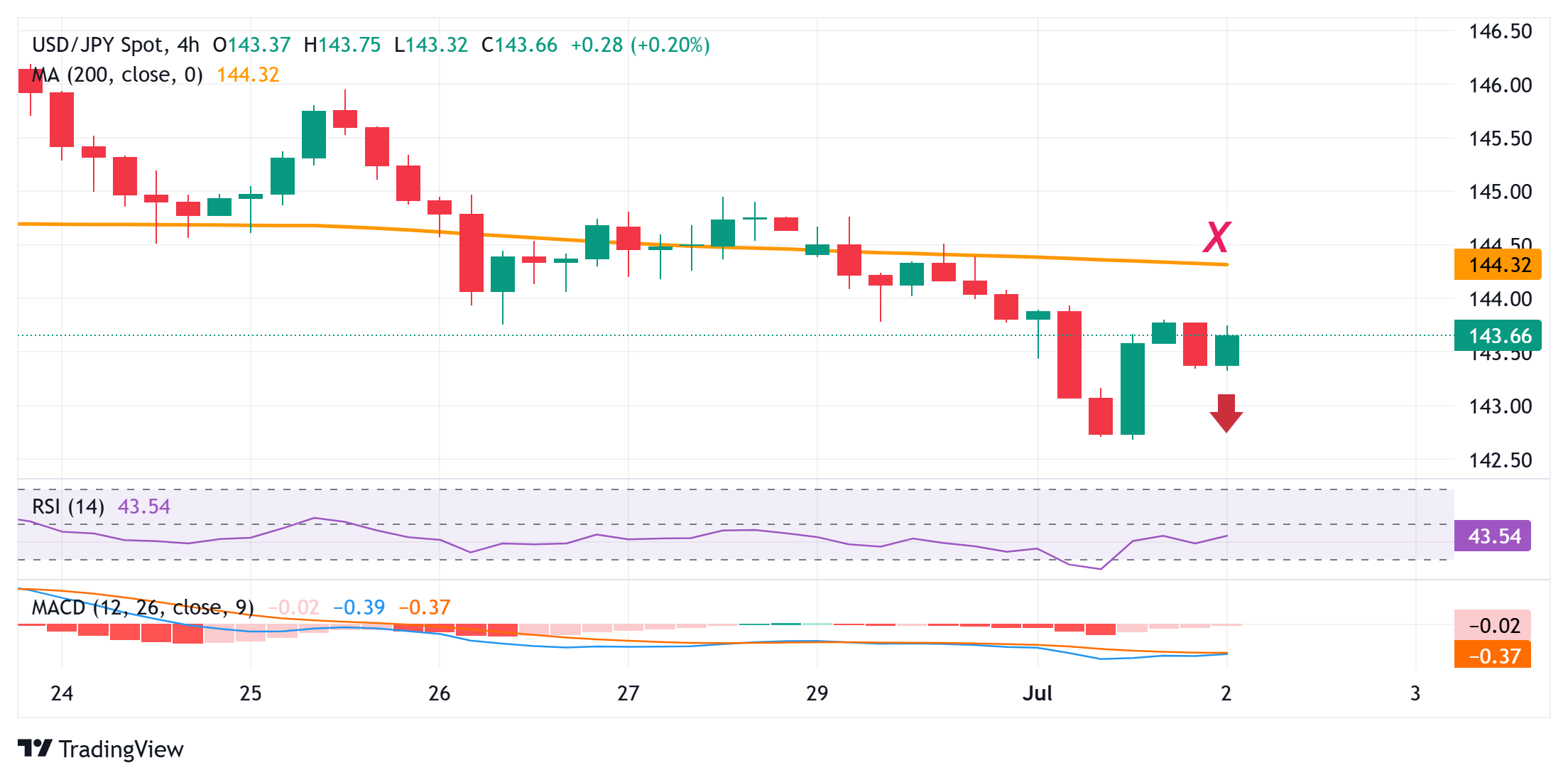Created
: 2025.07.02














![]() 2025.07.02 11:29
2025.07.02 11:29
The Japanese Yen (JPY) edges lower during the Asian session on Wednesday and moves away from a nearly one-month high touched against its American counterpart the previous day. US President Donald Trump expressed skepticism about reaching a trade deal with Japan and suggested that potential tariffs on Japanese imports would be higher than the 24% rate announced on April 2. This, along with the underlying bullish sentiment, is seen undermining the safe-haven status of the JPY.
Meanwhile, the Bank of Japan's (BoJ) cautious approach to unwinding its ultra-loose policy forced investors to push back their expectations for early interest rate hikes. Investors, however, seem convinced that the BoJ will stay on the path of monetary policy normalization as inflation has persistently exceeded its target for nearly three years. This could limit JPY losses, which, along with the lack of any US Dollar (USD) buying, should contribute to capping the USD/JPY pair's attempted recovery.

From a technical perspective, negative oscillators on 4-hour/daily charts suggest that any subsequent move up towards the 144.00 mark could be seen as a selling opportunity. This, in turn, should cap the USD/JPY pair near the 200-period Simple Moving Average (SMA) on the 4-hour chart, currently pegged near the 144.35 region. Some follow-through buying, leading to a subsequent strength beyond the 144.65 horizontal hurdle, should allow spot prices to reclaim the 145.00 psychological mark.
On the flip side, the 143.40-143.35 area could offer some support ahead of the 143.00 round figure and the overnight swing low, around the 142.70-142.65 region. Failure to defend the said support levels will reaffirm the near-term negative bias and make the USD/JPY pair vulnerable to accelerate the fall toward the May monthly swing low, around the 142.15-142.10 region. The downward trajectory could extend further towards testing sub-141.00 levels in the near term.
Tariffs are customs duties levied on certain merchandise imports or a category of products. Tariffs are designed to help local producers and manufacturers be more competitive in the market by providing a price advantage over similar goods that can be imported. Tariffs are widely used as tools of protectionism, along with trade barriers and import quotas.
Although tariffs and taxes both generate government revenue to fund public goods and services, they have several distinctions. Tariffs are prepaid at the port of entry, while taxes are paid at the time of purchase. Taxes are imposed on individual taxpayers and businesses, while tariffs are paid by importers.
There are two schools of thought among economists regarding the usage of tariffs. While some argue that tariffs are necessary to protect domestic industries and address trade imbalances, others see them as a harmful tool that could potentially drive prices higher over the long term and lead to a damaging trade war by encouraging tit-for-tat tariffs.
During the run-up to the presidential election in November 2024, Donald Trump made it clear that he intends to use tariffs to support the US economy and American producers. In 2024, Mexico, China and Canada accounted for 42% of total US imports. In this period, Mexico stood out as the top exporter with $466.6 billion, according to the US Census Bureau. Hence, Trump wants to focus on these three nations when imposing tariffs. He also plans to use the revenue generated through tariffs to lower personal income taxes.
![]()
Created
: 2025.07.02
![]()
Last updated
: 2025.07.02

FXStreet is a forex information website, delivering market analysis and news articles 24/7.
It features a number of articles contributed by well-known analysts, in addition to the ones by its editorial team.
Founded in 2000 by Francesc Riverola, a Spanish economist, it has grown to become a world-renowned information website.
We hope you find this article useful. Any comments or suggestions will be greatly appreciated.
We are also looking for writers with extensive experience in forex and crypto to join us.
please contact us at [email protected].
Disclaimer:
All information and content provided on this website is provided for informational purposes only and is not intended to solicit any investment. Although all efforts are made in order to ensure that the information is correct, no guarantee is provided for the accuracy of any content on this website. Any decision made shall be the responsibility of the investor and Myforex does not take any responsibility whatsoever regarding the use of any information provided herein.
The content provided on this website belongs to Myforex and, where stated, the relevant licensors. All rights are reserved by Myforex and the relevant licensors, and no content of this website, whether in full or in part, shall be copied or displayed elsewhere without the explicit written permission of the relevant copyright holder. If you wish to use any part of the content provided on this website, please ensure that you contact Myforex.
Myforex uses cookies to improve the convenience and functionality of this website. This website may include cookies not only by us but also by third parties (advertisers, log analysts, etc.) for the purpose of tracking the activities of users. Cookie policy